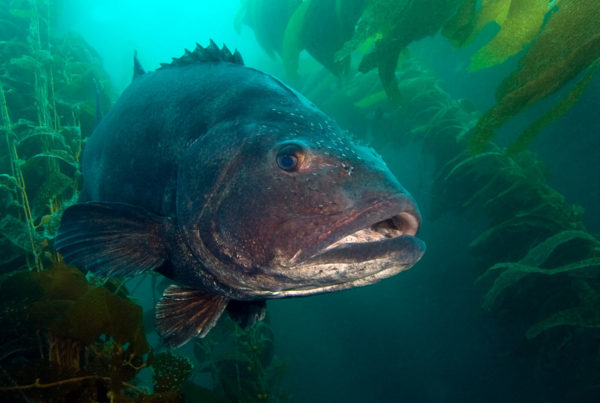California underwater photographers are always looking for bright colors to shoot against the muted greens, blues, grays, and browns of the reef and water. The striking contrasts make for excellent images. In Southern California waters one of the most brightly colored fish is the blue-banded goby (sometimes called the Catalina goby because it is so prolific at Catalina Island). These small fish (1 to 2.5″ in length) dot rocky reefs in 20 to 80 feet of water. They are brightly colored reddish-orange with neon blue bands. To make them even more interesting, their up-turned mouths are large and full of sharp white teeth.
But what makes them especially challenging for the underwater photographer is they are very difficult to get close enough to photograph.
First, you need the right equipment. Forget about cameras with framers. If anything gets within two feet of these guys they bolt into the protection of the reef. The ideal set-up is a camera with a macro-telephoto lens— something that you can stand off from your tiny colorful subject about 18 to 24 inches, yet still fill the frame. A housed SLR camera is usually the only way to go.
Next, you need an understanding on how the goby operates. To feed, the goby ventures forth to its perch on the reef to pick tiny bits of food from the water. But they are always close to the protection of their home— usually a small crevice or behind the spines of an urchin. You can try to approach them when they are out in the open, and sometimes you get lucky, but for the most part you’ll do better if you play by their rules.
If they feel safe, tucked in their holes, you can shoot away. It may take a bit of looking and positioning to find just a situation but it will pay off. A better situation is to find a goby that is out in the open but feels it is close enough to safe sanctuary that you can approach very close. Gobies that hang around urchin spines seem to be ideal for these kinds of shots. A side benefit of photographing gobies around urchins is the dark spines often provide a dramatic backdrop for the brightly colored goby and the spines also give the photo a more 3-D feel. Be aware, however, of your strobe angles as urchin spines can cast distracting shadows on the goby.
In finding a goby hunkered down near an urchin, you will still need to approach slowly so you don’t alarm the fish.
An interesting feature of the blue-banded goby is their eyes. While the rest of the fish is brightly colored, the eyes are large and dark, but there is detail. Overexpose your shots 1/2 to a full stop to bring in the eye detail. This will also enhance the body color of the fish without blowing it out.
Some careful techniques in photographing the blue-banded goby will reward you with fantastically colorful shots that will look like they were taken at a tropical reef.










